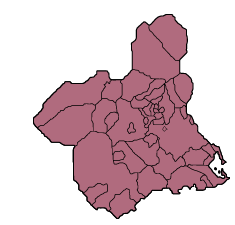Alicante wildfire forces 200 people from their homes
- Tue, 16.04.24 - 09:08


The deadly blaze in Tárbena has been raging for two days straight Firefighters in the Alicante town of T&a...
The deadly blaze in Tárbena has been raging for two days straight Firefighters in the Alicante town of T&a...
Alicante is enduring the worst drought in more than three decades with very little rain in sight With the worst d...
This trail in the Valencian Community features a challenging climb of 6,600 steps amidst a verdant rocky landscape ...
The deadly blaze in Tárbena has been raging for two days straight Firefighters in the Alicante town of T&a...
Alicante is enduring the worst drought in more than three decades with very little rain in sight With the worst d...
England and Barca manager Terry Venables passed away recently, but do you know how else he is linked to Spain? Fo...
Both the victim and the main suspect in the murder are thought to be foreigners The corpse of a woman was found i...
The 31-year-old was wanted in the United States for illegal proceeds totalling up to 30 million dollars A British...
Get help with menopause anywhere in Europe with The Women's Health Clinic In a bid to extend their reach and ...
Alicante is enduring the worst drought in more than three decades with very little rain in sight With the worst d...
Great live entertainment on the Explanada Barnuevo in Santiago de la Ribera! The Steam Brass Band is one of the most ...
Works by the Yecla-born artist at the Casa Municipal de la Cultura in Yecla The evening of April 4 sees the opening o...
The event will feature exquisite dishes from 20 Costa Blanca eateries An event not to be missed in Los Montesinos...
Great live entertainment on the Explanada Barnuevo in Santiago de la Ribera! The Steam Brass Band is one of the most ...
Swing and traditional New Orleans music in a free concert in the Plaza de España in San Javier It is a privile...
One of a series of tours coinciding with the International Sports Tourism Week in Yecla This guided route takes v...
Visit the legendary mountain and the 10,000-year-old prehistoric artwork of Yecla This guided hike at the legendary m...
Nurses, physiotherapists and other nursing home employees wanted in Spain Caser Residencial, the nursing home and...
Nurses, physiotherapists and other nursing home employees wanted in Spain Caser Residencial, the nursing home and...
Nurses, physiotherapists and other nursing home employees wanted in Spain Caser Residencial, the nursing home and...
Find out how you can donate blood in Spain and if you’re eligible Blood donation is a vital contribution to...
It’s a widely held belief in Spain that water canisters will prevent pets from marking their territory In r...
Find out everything you need to know to visit Spain’s unique festival of fireworks and fun The Valencia Fal...
Go along to the Rawhiders clubhouse in Callosa de Segura for good food and friendly company The Costa Blanca Rawh...
Carwash, airport transfers and more without any cancellation fees from Lowcostparking.es If you need to park your...
DGT Spain has confirmed that new drivers will have to pass a course to ride 125cc motorbikes Spain's General ...
DGT Spain has confirmed that new drivers will have to pass a course to ride 125cc motorbikes Spain's General ...
DGT Spain has confirmed that new drivers will have to pass a course to ride 125cc motorbikes Spain's General ...
Prepare your property for any weather with Leak Proof all-in-one waterproofing and UV-resistant surface Did you k...
Sometimes it’s tempting to hire the first, cheapest or nearest handyman you find, but there are good reasons to sh...
A new and controversial law may mean that Valencia estate agents have to meet strict requirements or else close down ...
Yes, you can do your Spanish tax declaration online… but it’s not the easiest way Taxpayers in Spain...
Both the donor and the beneficiary will have to pay some taxes in Spain Until recently, donating real estate to a...
Here’s what you need to know about avoiding the pitfalls of black money in property transactions in Spain I...
Prepare your property for any weather with Leak Proof all-in-one waterproofing and UV-resistant surface Did you k...
What really is the need to get a Pre-Purchase Technical Inspection for your Costa Blanca property? Purchasing a p...
Prepare your property for any weather with Leak Proof all-in-one waterproofing and UV-resistant surface Did you k...
Where you should post online to sell your house in Spain and how to speed up the sales process When you want to s...
Prepare your property for any weather with Leak Proof all-in-one waterproofing and UV-resistant surface Did you k...
Prepare your property for any weather with Leak Proof all-in-one waterproofing and UV-resistant surface Did you k...
Prepare your property for any weather with Leak Proof all-in-one waterproofing and UV-resistant surface Did you k...
Find out how you can donate blood in Spain and if you’re eligible Blood donation is a vital contribution to...
Find out how you can donate blood in Spain and if you’re eligible Blood donation is a vital contribution to...
Removing the Golden Visa will have very little real-world effect for Spain and for foreign buyers The Spanish gov...
Passengers can benefit from unlimited free train trips in Spain all summer with just a small deposit Spain’...
A Spanish court has decreed that LaLiga can fine viewers of pirate football, and not just the service providers LaLig...
Temperatures will remain more typical of May or June in most of Spain this coming week Temperatures expected on W...
The 31-year-old was wanted in the United States for illegal proceeds totalling up to 30 million dollars A British...
